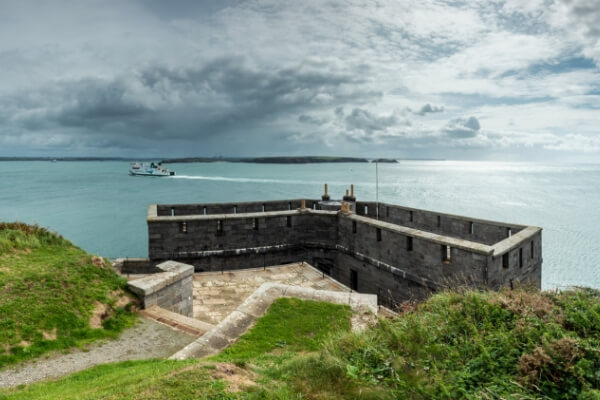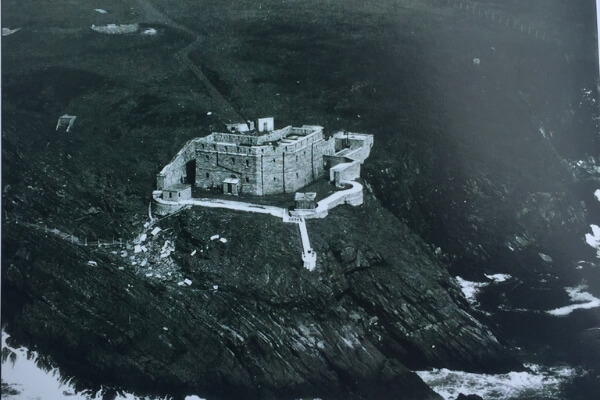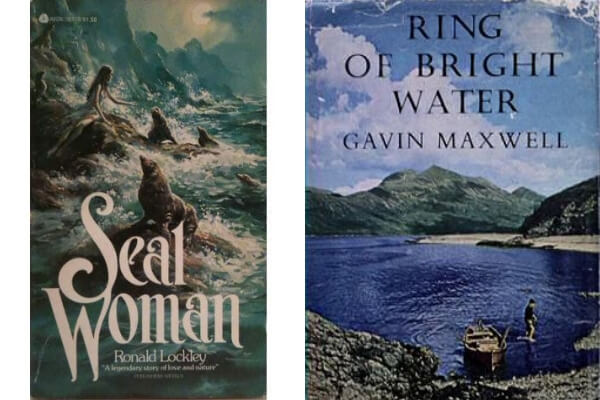
West Blockhouse Fort in Pembrokeshire is a beautiful paradox of a building: it seems both to rise from the rock and to soar above the sea. You approach it on foot down an angled grass track, having bumped in car or van for several miles down narrowing roads and a tapering peninsula. And there, at last, ahead of you are the upper storeys and crenellated roof of the fort, which appears – somehow, impossibly – to be hovering above the waves. Gannets cruise stiff-winged above granite coping-stones, white as magnesium flares. Oil tankers trundle up the deep-water channel towards the refineries at Milford Haven, shepherded on either flank by a snub-nosed boot-black tug boat. How is this building not either flying or floating?, you wonder.
The trick of the fort is two-fold: it is built on the last jag of cliff on the mainland, and it has a twenty-foot-deep dry moat around its inward side. This is what makes it seem to levitate as you near it. It was built in the 1850s as part of a coastal defence system constructed to counter the perceived invasion threat from Napoleon III. Other forts dot the islands and promontories of the haven, their lines of fire designed to overlap and intersect, allowing no possibility of an enemy vessel creeping through undamaged.
Like many of the thousands of defensive structures scattered along Britain’s coastline, from Martello Towers and pillboxes to Iron Age brochs, West Blockhouse has been repurposed by successive conflicts. Its limestone walls – so finely dressed that the stones still sit snug and flush 160 years on – were constructed just as sail gave way to steam, and as marine artillery went through a period of intense augmentation. The fort’s walls could have withstood a twelve-pound ball from an oak-hulled frigate; they would have collapsed quickly under the onslaught of a screw-driven ironside. It was obsolete within years of its construction, an anachronism overtaken by naval technology. But in the early 1900s the fort was re-armed and re-fortified, and during the First World War it was garrisoned as a Counter Bombardment Battery. Then during the Second World War ack-ack and machine-gun emplacements were sited there, firing up at the German bombers targeting Pembroke Docks. Now, in more domestically peaceful times, it is a Landmark Trust property that one accesses via a drawbridge over the dry moat, to take temporary possession of a truly extraordinary structure – from the twelve-foot-high ceilings to the musket-slit windows that give onto the channel’s glittering water.

Four years ago I finished work on a book called Landmarks, which gathered together in eleven glossaries more than 2000 terms for landscape, nature, weather and creaturely life, drawn from across Britain and Ireland, and including terms from over thirty languages, dialects and sub-dialects, from Hebridean Gaelic to Cornish, Welsh to Estuary English. It was the aim of that book to celebrate the rich word-hoard that these islands possess for aspects of place and land, built up over millennia of close contact with an exceptionally varied terrain and seascape.
In the course of research for that book, I became fascinated by coastal languages; from the vernaculars of sailors and fisherman off the north-west coasts of England, to the Shetlandic traditions of the haaf (deep-sea fishing), which included the absolute proscription of uttering certain terms once at sea, for fear they would bring accident or storm upon a boat. Researching these cultures, I came to understand that Britain has long feared assault both by and from the sea: its enemies have long been at once foreign powers and the forces of the ocean itself, gnawing and smashing away at the coast. So it is that, for centuries, we have armoured ourselves against these two possible invasions, with pill-boxes and with groynes, with forts and with breakwaters – and with stories and superstitions, too.
After staying in the West Blockhouse Fort for more than a few days, it becomes hard not to think defensively. Hung on the walls are copies of early-twentieth-century plans for the building; they include ordnance data, magazine capacities, arcs of fire, perimeters and garrison details. How would one resist a landwards attack, you begin to wonder? What would life have been like for the soldiers barracked here, on this cusp of land, with no family to keep them company and no conflict to keep them busy? Your vision and imagination get militarised; sea-birds start to resemble incoming aircraft; you assess the crags at the fort’s foot for their scaleability from the sea; the reverberating booms of the nearby fog-horn station startle like explosions.
Among the books in the library at the West Blockhouse is Ronald Lockley’s novel Seal Woman (1974). Lockley was the natural historian and field biologist who pioneered modern bird observation in Britain, and much of whose ornithological research was carried out on the islands of Skokholm and Skomer, close to West Blockhouse Fort. During World War II Lockley worked for naval intelligence; his tasks including assessing which beaches and bays of the Welsh and Irish sea-boards might offer invasion possibilities for the Germans. Seal Woman is a wild, erotic psychodrama that combines Lockley’s two ‘ways of seeing’ – natural-historical and military – and describes the fascination of a British intelligence officer for a young Irish girl who may or may not be a selkie or seal-woman. It is a troubled and troubling text, not least in the erotic attention it directs towards a character who is, in the book’s early chapters, still a child. I take it to be one of the many damaged books by writers who served in the Second World War and were still working the experience through years or even decades later (I count among these ‘aftermath’ books Patrick Leigh Fermor’s A Time Of Gifts, and Gavin Maxwell’s Harpoon At A Venture and Ring of Bright Water).

The week I stayed in West Blockhouse happened to coincide with the summer that I was finishing a book of my own called Underland, on which I had been working for six years. Underland’s subject is all that lies beneath; the buried depths of both landscapes and minds; the marks we have left and will leave behind in the strata; the journeys and descents we have made over thousands of years and across global cultures, down into darkness in search of meaning. The book’s medium, if I may put it like that, is ‘deep time’ – the chronology kept by oceans and rocks, rather than by humans, measured in epochs and aeons rather than hours and years.
West Blockhouse was – unexpectedly to me – the perfect place in which to complete Underland. Each day I would take an hour to clamber down the red sandstone cliffs around the fort (formed around 420 million years earlier in the Devonian period), find what climbers call a sentry-box – i.e. a niche where one can rest safely – and there work through the line-edit of a chapter, while watching the life of the sea and the coast. Dolphins circling and hunting. Lobster fishermen hauling their pots. Elegant yachts plying out of the channel. Gannets rocketing into the water, pulling blue nets of air down with them. Ravens circling, cawing, hexing. One night I saw a solar corona – a halo of light refracted in ultra-high-altitude ice-crystals, the most perfect I have seen outside the Arctic.
I took to picking up fragments of stone, and the shed feathers of gulls and ravens, and keeping them with the book’s typescript, in order to remind me where I’d completed it – there at the fort that seemed both part of the rock and part of the air.
Explore our other seaside holiday properties.
Browse seaside stays